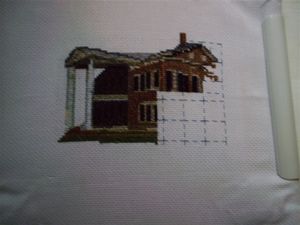Years ago when I first tried to cross stitch (even working from small to average-sized charts) I was overwhelmed, losing my place on my fabric as well as my chart. But after discovering a few tricks, I found even stitching from full-size cross stitch charts easy and have since completed countless larger-than-average projects.
Gridding—Tip #1 for Stitching Large Cross Stitch Designs
Gridding is simply a method of dividing your cross stitch fabric into 10 x 10 squared grids to match your pattern. Maybe you can’t keep your place on the entire fabric, but it’s not hard when you only work with a small grid of 10 squares x 10 squares. A few gridding tips include….
1. Grid every two squares. Rather than threading every square, skip over every couple of squares. This makes it easier to cut away thread when you’re finished with each 10 x 10 grid.
2. Mark each corner of a 10 x 10 grid with an intersecting “L”. If you want to make your grid even simpler, mark off the four corner of each grid (instead of basting every square). This saves you the mess (as well as time) of cutting away more basting thread.
3. Select dark-colored thread for light-colored fabric and white thread for darker fabrics such as black and navy.
4. Use Water soluble quilters’ pens. These also work well, although some stitchers contend that the blue lines could reappear years later. Personally I’ve never had the pen lines reappear, however I now use thread instead of a quilting pen, simply because I find it easier to mark my fabric. Of course, it’s a matter of personal choice—Select whatever method works best for you.
5. Cut your basting thread after completing each grid.
Pre-thread Your Needles—Tip #2 for Stitching Large Cross Stitch Designs
By pre-threading and organizing your needles before you take that first stitch, you’ll save time. First divide your pattern into four sections. Next, take a scrap fabric (about the size of 8 x 10 notebook paper) and place it next to your stitch. Then, using masking tape, make four columns (representing each of the four sections of your chart.) on the fabric. Before starting a new section of your pattern, see what floss colors are used for the area. Next, thread your needles, labeling them on the masking tape. Position the needles on the fabric according to colors used in each section, alongside the masking tape you’ve labeled (with both the symbol and the floss number.) When you have left-over thread, just stick the needle back into your scrap fabric where you can easily find it the next time you’ll need that particular floss colorthat color again.
Use Labeled Floss Bags—Tip #3 for Stitching Large Cross Stitch Designs
Floss bags (similar to Ziploc bags) are excellent for organizing floss. Count out the number of colors you’ll need and secure the bags with two rings. Then label each bag with a permanent market, indicating both the floss number, as well as the cross stitch symbol. Make sure the floss numbers are in numerical order so they’ll be easy to find when you start to stitch. (To reuse the bag, use masking tape so you can easily tape over the information when you’re finished and ready to begin your next project.) If your local needlework store doesn’t have floss bags, you can also use sandwich or snack-sized Ziploc bags. Just make sure to hole-punch holes on both sides for the rings.
Enlarge Your Chart—Tip #4 for Stitching Large Cross Stitch Designs
Sometimes large charts have hard-to-read symbols all crammed onto one page, which makes it challenging for aging eyes. Most copiers (found in commercial office supply stores such as Office Depot, Staples, and Office Max) allow you to increase (as well as reduce) the size of your copy. Or, if you make your own charts with photo-to-chart computer software such as Pattern Maker, adjust the design so it’s on four separate pages. This makes is much easier than having the entire design on a single page, or even double pages.
Once you apply these tips you won’t shy away from large designs, but will actually prefer them. What’s more, soon you’ll probably come up with your own helpful tips for stitching large cross stitch projects.
